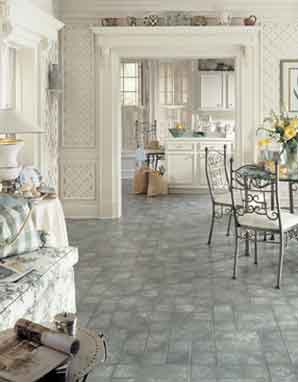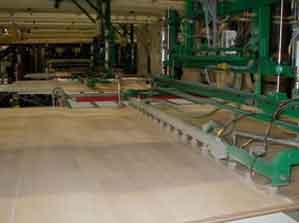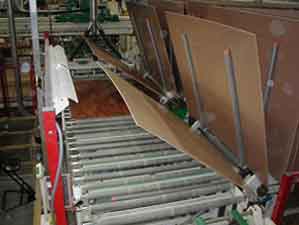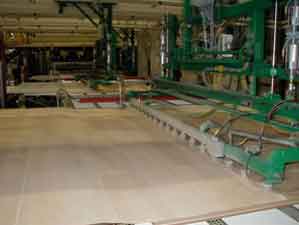Laminate Construction
How laminate flooring is manufactured.
A home consists of what’s under your roof and what’s under your feet. Floor coverings have a huge influence on your home and home life.
They impact interior beauty, design, comfort, livability and upkeep, thus floor coverings can make, or break, a home.
In this section we explain how laminate flooring is manufactured.
Being familiar with laminate construction helps you understand and evaluate its performance aspects: why certain laminate floors wear better and longer.
In the section “Welcome to Laminate” we told you laminate is a manufactured product that is a true look-a-like of hardwood flooring, natural stone and many other types of flooring.
Now, you may be wondering, how can laminate flooring resemble these other products so closely?
The answer lies in the process of how laminate is made.
\It’s a combination of the precision of today’s manufacturing techniques and the expertise of the men and women behind the materials, machines and methods that create laminate.
All work in harmony to produce a beautiful, functional flooring that closely simulates other beautiful, functional floorings.
To understand laminate, picture a four-layer cake.
Today’s laminate floors are available in a multitude of designs, patterns, and textures, yet they all consist of four main components that are bonded together.
The bottom layer, or backing, is a melamine plastic layer that lends dimensional stability to the planks or tiles and also helps guard against moisture from the sub-floor. (Moisture infiltrating any flooring, is the enemy.)
The next layer is a core board, generally made from high-density fiberboard or particle board which may also contain melamine plastic resins that help improve the moisture resistance of the core.
Then a decorative layer or print film is adhered on top of the core board giving the floor its hardwood or tile look.
This decorative layer is a printed high-resolution photo-reproduction of wood grain, natural stone or ceramic tile pattern. (Now you know how the look-a-like is born.)
On the top of our “cake” is a durable wear layer, providing protection and stain resistance.
Today, many wear layers also contain aluminum oxide, as well as melamine resin, and that creates exceptional durability. The kind that will stand up to the most active household.
All four layers are then combined in a high-pressure or direct pressure manufacturing process.
Now we’ll take you through the manufacturing process of laminate.
Step 1: stacking with pinpoint accuracy.
The process begins with the assembly of the 4 layers of raw materials in large sheets.
This typically takes place on a production line, where modern technology enables each layer to be stacked on top of another with incredible accuracy and precision.
How precise you may ask? Most manufacturers use sophisticated electronic calibrating equipment and digital camera systems to keep the sheets in perfect alignment.
The backing layer is first on the line, with the core board placed directly on top of that.
Next, the printed decorative layer is stacked on top of the core board. The final layer to be stacked on is the wear layer.
Step 2: cake baking under pressure.
Once the 4 layers have been stacked, they are ready for pressing.
The presses used to create laminate flooring have hydraulic rams that apply tremendous pressure to the stacks.
The stacks of layers are pressed at high temperatures reaching 400 degrees Fahrenheit, with up to 600 pounds per square inch of pressure for 20 to 30 seconds.
Manufacturers carefully monitor the time and temperature when pressing the layers to successfully cure and bond the stacks into a single sheet of finished decorative laminate.
If the laminate that is being manufactured is designed to have a textured surface, the press has specialized plates that imprint the textured pattern onto the sheets, creating more natural looking planks or tiles.
Step 3: take a break and cool off.
After the sheets are pressed they are left to cool to ensure that they fully cure and to prevent any surface imperfections.
Then the sheets are stacked and stored for a time so that they can continue to acclimate, thereby enhancing the stability of the boards.
Step 4: cutting, profiling and inspecting.
Once the boards are fully acclimated, they are milled, or cut into planks or tiles.
The freshly cut planks or tiles then move on to be profiled. Multiple profiling saws create the tongue and groove edges on the sides of the planks or tiles that enable the floor to lock together with ease.
The blades on the profiling saws use electronic and laser systems that produce incredibly accurate edges for a perfect fit. Further assurance of the precision of your floor.
The finished planks or tiles then go through a quality inspection and are checked for color, texture, finish, size and correct interlocking capabilities.
Once approved, the planks or tiles are then stacked, packaged and loaded onto trucks for distribution. Your flooring could be on one of those trucks.
Please, take your time deciding.
Now that you know how laminate flooring is made you can understand why it’s a beautiful, durable and cost-efficient flooring answer for many homes, and homeowners, across the county.
Those are the basics of laminate construction and manufacturing.
We hope that the information we’ve featured here leads you to a better understanding of how this beautiful and versatile material is constructed and underlines the fact that a well-chosen laminate floor can help make your home.




